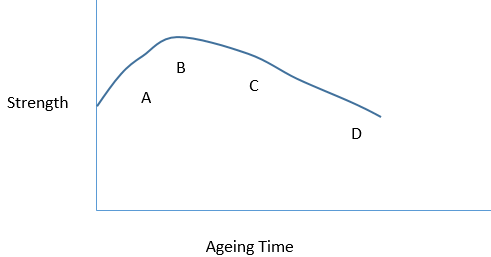This set of Mechanical Metallurgy Multiple Choice Questions & Answers (MCQs) focuses on “Fiber Strengthening”.
1. In precipitation hardening, the second phase must be soluble at a higher temperature and solubility ____________ with decreasing temperature.
a) increases
b) decreases
c) remains constant
d) does not follow define the path
View Answer
Explanation: The solubility of second phase particle should decrease with decreasing temperature so that at room temperature they act as a medium for dislocation hindering.
2. The solubility of second phase particles in dispersion hardened system is _____________ compared to precipitation-hardened system.
a) higher
b) lower
c) equal to
d) no relation
View Answer
Explanation: In the hardened dispersion system, the second phase particles are externally added to the system. So their solubility is much less in matrix compared to hardened precipitation system where second phase particles are part of the system only.
3. The coherency between the parent phase and particle is much better in precipitation-hardened alloys compared to dispersion hardened alloys.
a) True
b) False
View Answer
Explanation: The second phase particle in the precipitation-hardened system come out of matrix only, so there is atomic matching between planes, and define the relationship between orientation. But in dispersion hardening, it is like mechanical mixing, so not coherency between matrix and particles.
4. The most superior hardening technique for high temperature application is ___________
a) precipitation hardening
b) dispersion strengthening
c) cold working
d) thermomechanical treatment
View Answer
Explanation: Other than dispersion hardening rest all hardening method loses their strength at the higher temperature. In Cold working and thermomechanical processing dislocation entanglement give strength, but at high-temperature dislocation are mobile sufficiently to bypass the barriers. The precipitate becomes soluble in the matrix at high temperature. So only suitable method available at high-temperature application is dispersion hardening.
5. In aluminium-4.4% copper alloy system, which of the following represent the correct order?

a) A=GP Zone, B=θ’’, C=θ’, D=θ
b) A=θ’’, B=θ’, C=θ, D=GP Zone
c) A=GP Zone, B=θ, C=θ’, D=θ’’
d) A=θ, B=θ’, C=θ’’, D=GP Zone
View Answer
Explanation: In Al-Cu alloy system with aging time first GP Zone forms, than θ’’->θ’->θ.
The strength depends up the coherency of the precipitate and is maximum for θ’’.
6. The chemical composition of θ’ is _______
a) CuAl3
b) Cu
c) CuAl
d) CuAl2
View Answer
Explanation: First, the GP Zone form, which is a small cluster of copper atoms, after the CuAl2 particle precipitate on (100) plane and coherent with the matrix until it reaches θ.
7. A precipitate particle in matrix provide strength to the material if the particle and matrix interface is considered. Which interface will provide maximum strength?
a) Coherent interface
b) Semi-coherent
c) Incoherent
d) Hardness does not depend up coherency
View Answer
Explanation: There are 2 factor which plays a role in deciding the increased strength of the material.
(1) Lattice strain due to the particle on the matrix to maintain coherency
(2) Interfacial energy of interface to pass a dislocation.
So in case of coherent interface, dislocation can easily glide from the matrix to particles. In case of incoherent interface there in no interfacial strain because there is no matching between atomic planes of particle and form. So in the case of semi-coherent interface, there is lattice strain and resistance to dislocation movement.
8. The over aging of alloy ______________
a) increase the strength of the material
b) decrease strength of the material
c) increase the life of the component
d) decrease the size of the precipitate
View Answer
Explanation: The Over aging is the process of heating the alloys at a higher temperature for a longer time. This cause precipitate to grow larger in size and distribution of precipitates in the matrix will be partial. This results in the reduction in the strength of the material.
9. What will be interparticle spacing between the precipitate particles of radius r=2 micron. The volume fraction of particles in the matrix is 10%?
a) 10 Micron
b) 20 Micron
c) 24 Micron
d) 4 Micron
View Answer
Explanation: Assuming interparticle spacing is λ, volume fraction f, and radius r, then
-> λ=4(1-f)r/3f
λ=4(1-0.1)2/(3*0.1)
λ=24 Micron.
10. Which of the following orientation of fiber will provide maximum strength in composite?
Blue colored is the matrix, and black is fiber.
a)

b)

c)

d)

View Answer
Explanation: If the fiber in the matrix is oriented in parallel to the loading direction, they will provide maximum strength. Long continuous fiber offers more strength than strong discontinuous fiber.
Sanfoundry Global Education & Learning Series – Mechanical Metallurgy.
To practice all areas of Mechanical Metallurgy, here is complete set of 1000+ Multiple Choice Questions and Answers.
If you find a mistake in question / option / answer, kindly take a screenshot and email to [email protected]
- Apply for Metallurgical Engineering Internship
- Check Metallurgical Engineering Books
- Practice Metallurgical Engineering MCQs
- Check Mechanical Metallurgy Books
